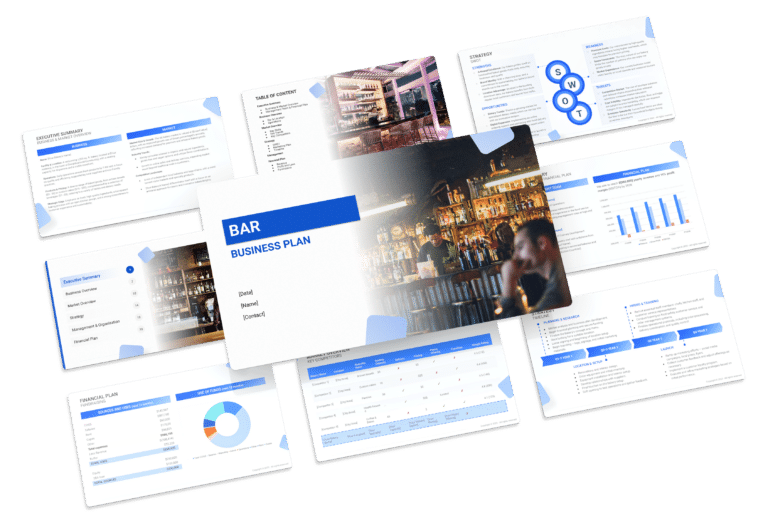SWOT Analysis for a Fast Food Restaurant (Example)

Integral to a fast-food restaurant’s business plan, a SWOT analysis assesses internal strengths and weaknesses, as well as external opportunities and threats. Strengths, like efficient service and a popular menu, contrast with weaknesses such as high employee turnover or dependence on specific ingredients.
This strategic evaluation unveils the restaurant’s market stance, spotlighting potential growth areas. For instance, opportunities may arise from a growing demand for convenience, while threats could originate from intense competition or fluctuating consumer preferences.
This article will explore diverse examples of strengths and weaknesses, providing fast-food restaurant owners valuable insights for strategic business planning.

Strengths
- Strong Brand Recognition: Building a strong brand identity is crucial in the fast food industry. Establishing a recognizable and trusted brand can lead to customer loyalty and repeat business.
- Example: McDonald’s is a prime example of a fast food restaurant with exceptional brand recognition, which often results in customer trust and loyalty.
- Efficient Supply Chain: Efficient supply chain management is essential for ensuring consistent quality and timely delivery of ingredients. A well-optimized supply chain can lead to cost savings and better customer satisfaction.
- Example: Subway’s supply chain management allows them to offer a wide variety of fresh ingredients to customize sandwiches, contributing to their popularity.
- Menu Diversification: Offering a diverse menu with a wide range of options can attract a broader customer base. Catering to various tastes and dietary preferences can increase sales and customer satisfaction.
- Example: Taco Bell’s menu includes vegetarian and vegan options, appealing to a more health-conscious and diverse clientele.
- Digital Presence: Leveraging technology and an online presence can enhance customer convenience through online ordering, delivery services, and mobile apps.
- Example: Domino’s Pizza’s robust online ordering system and mobile app have made it incredibly convenient for customers to order pizza, boosting sales.
Weaknesses
- High Employee Turnover: The fast food industry often faces high turnover rates due to the demanding nature of the job and relatively low wages. High turnover can lead to increased training costs and decreased service quality.
- Example: High employee turnover at a local burger joint can result in inconsistent food preparation and service quality.
- Quality Control Challenges: Maintaining consistent food quality across all locations can be challenging. Inconsistencies can lead to dissatisfied customers and damage the brand’s reputation.
- Example: If a fast food chain doesn’t enforce strict quality control measures, a customer receiving a poorly made sandwich can impact their perception of the entire brand.
- Health and Nutrition Concerns: As consumers become more health-conscious, fast food restaurants face scrutiny for offering high-calorie, low-nutrition options. Addressing these concerns is essential to stay competitive.
- Example: A fast food restaurant that doesn’t offer any healthy menu choices may struggle to attract health-conscious customers.
- Competitive Pricing Pressure: Price competition is fierce in the fast food industry. Maintaining profitability while keeping prices affordable can be a constant challenge.
- Example: A local pizzeria may struggle to compete with larger chains that can offer lower prices due to economies of scale.
Opportunities
- Healthy Menu Innovations: Embracing the trend toward healthier eating by introducing low-calorie, high-nutrition menu items can attract health-conscious customers.
- Example: A fast food restaurant could introduce a range of salads, wraps, and smoothies to cater to health-focused consumers.
- Online and Delivery Expansion: Investing in robust online ordering systems and delivery services can tap into the growing demand for convenience, especially in a post-pandemic world.
- Example: A fast food restaurant can partner with popular food delivery apps like UberEats or DoorDash to expand its reach.
- Global Expansion: Exploring international markets can provide opportunities for growth and increased revenue. Adapting menus to local tastes and preferences is key to success.
- Example: Subway’s global expansion strategy involves tailoring its sandwiches to local tastes, such as offering different types of bread and fillings in different countries.
- Sustainability Initiatives: Implementing sustainable practices, such as using eco-friendly packaging and sourcing locally, can attract environmentally-conscious customers and improve the brand’s image.
- Example: A fast food chain can switch to biodegradable packaging and promote its efforts to reduce its environmental footprint.
Threats
- Health Regulations: Increasing health regulations and scrutiny can impact the fast food industry, leading to stricter menu labeling requirements and potential restrictions on certain ingredients.
- Example: Government regulations limiting the use of trans fats in cooking oils can affect the taste and preparation methods of fried foods.
- Economic Downturns: Economic recessions can lead to reduced consumer spending, affecting fast food sales as customers cut back on dining out.
- Example: During a recession, people may opt for more affordable home-cooked meals rather than dining at fast food restaurants.
- Intense Competition: The fast food industry is highly competitive, with new entrants constantly emerging. Established chains must continually innovate to maintain their market share.
- Example: A new gourmet burger joint entering the market can pose a threat to existing fast food burger chains.
- Changing Consumer Preferences: Rapid shifts in consumer preferences, such as a sudden demand for plant-based options, can catch fast food restaurants off guard.
- Example: If a fast food chain doesn’t adapt to the rising popularity of plant-based burgers, it may lose customers to competitors offering such options.





